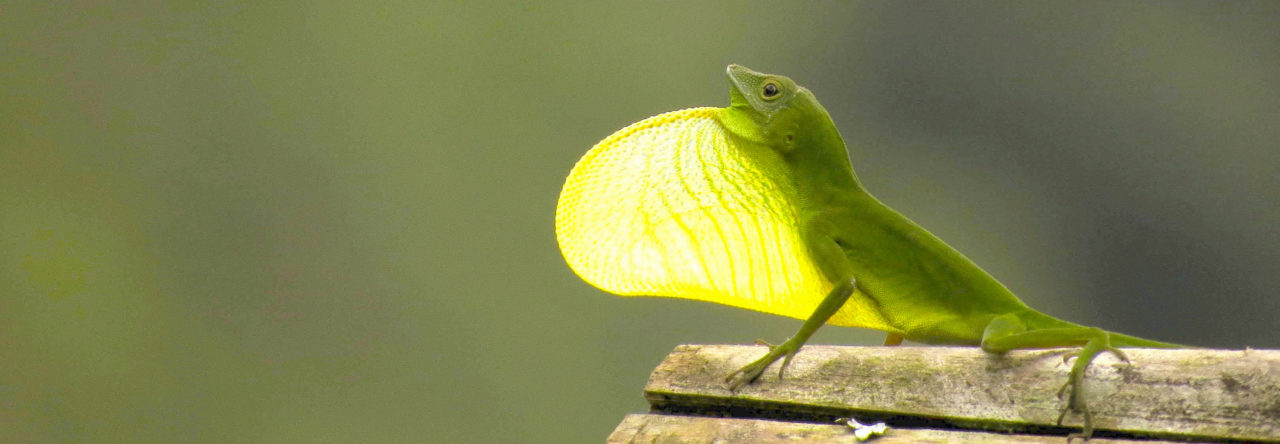In the good old days, back when grad students weren’t afraid to push the boundaries and TSA didn’t exist, we used to transport lizards in the passenger cabin of airplanes. We’d simply put them, one to a plastic bag, in a backpack or duffle bag and bring them onboard as carry-on luggage. Rarely was this a problem.
Lizard guys weren’t the only ones to do this. I remember a frog biologist telling me of the time he brought a bunch of coquis back to his lab from Puerto Rico. They were snuggled into their individual little containers, dark and moist, and apparently quite content, because midflight they started calling as only a coqui can. Of course, this attracted the attention of other passengers. As they looked around, up and down and sideways, speculating about what was causing the ruckus, my colleague simply buried his nose in his book and kept quiet.
I only twice had trouble carrying anoles onboard. The first time was in Gainesville, Florida, in 1987. I was just starting out on my anole research and had flown to Miami to collect a sample of the superbly diverse, if non-native, anole fauna of that fine city. I collected five species, including A. carolinensis (the only native species of the lot), A. sagrei, A. distichus, A. cristatellus, and several magnificent knight anoles, A. equestris, the largest anole species. I then flew to Gainesville to meet with anole expert Alan Pounds, anoles in tow. No problem. However, on the way back, things did not go smoothly. The Gainesville Airport, at that time, was a small, rinky-dink affair. When I got to security, I put my duffle bag full of lizards onto the conveyor belt and through the x-ray machine it went (as an aside, as far as I could tell, no lizard suffered any harm from being x-rayed). The inspector, a small, round, white-haired and cranky woman, took one look at her monitor and barked, “You’ve got an alligator in there.” I pulled out a small A. carolinensis and tried to convince her otherwise, but to no avail. It was the only time I had to check my bag o’ anoles.
The second problem trip was a year later in Jamaica. In our travels, we would put the lizards in gallon-sized plastic bags, inflated with air (this was pre-Ziploc days—such bags are hard to find now). Every two days, we would change the bags, and this worked fine. Except on this particular trip, I failed to bring enough Baggies® with me, so we had to scour local shops for Jamaican made bags, which we eventually found. However, unbeknownst to us, these bags were not well made. On the day we were to fly out of Montego Bay en route back to California, we checked in and passed through security without incident. I thought the coast was clear. But then, as they called the flight, I realized that the security staff—all female, all dressed in elaborate red uniforms, including ornate hats—were hand-searching each piece of carry-on luggage. My heart sank. When I got to the front of the line, the woman unzipped my duffel bag, reached in, and started rummaging around with her hands, but without looking down. Saved! Or so I thought. Unfortunately, several plastic bags had split open at the seams, freeing their captives, and a beautiful male Anolis grahami jumped out of the duffel and onto the table. This the inspector did see. She immediately let out a scream and—I kid not—stood on a chair. I thought all was lost, but from her lofty perch, she yelled at me to catch the lizard and get on the plane, which I quickly did, returning to the lab without further trouble.
So, in talking to fellow from Transport Executive’s man and a van Plymouth , reminisced on how we used to do it in the old days. No packaging lizards in coolers for transport in air cargo or checked luggage, no elaborate containers, no fuss, no muss. It was a simpler, easier time, and usually it worked quite well. I always suggest to travelers these days that they consider taking a duffel bag and try hand carrying their lizards, but then again, we can only guess how TSA would react (and the x-rays are probably now a lot stronger).
Note added June 2, 2013: Since this post was published in December 2010, a number of commenters have asked about the consequences of transporting lizards on airplanes. There are two issues for doing so. First, capturing a lizard and taking it somewhere else almost always requires a collecting and/or export permit from the state or country of origin. Failing to do so is breaking the law. Moreover, the United States’ Lacey Act makes it a felony to import into the United States any animal illegally (i.e., without permission) collected in or exported from another country. Let me reiterate: this is a felony. If you get caught doing this, you are in big trouble. If you are transporting animals legally into t
Second, can one bring lizards onto airplanes. As far as I am aware–though I may be wrong, so you should check yourself–there are no laws against doing so. However, airlines have regulations about what you can bring onto their airplanes and how you can do so, so you’ll need to check with the airline. In addition, there is the question about how to get the animals through security if you are transporting them with you. As always, the internet is a good place to start in trying to figure out what is allowed and how to proceed. Here’s one article I found in a quick Google.







